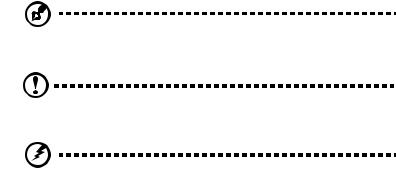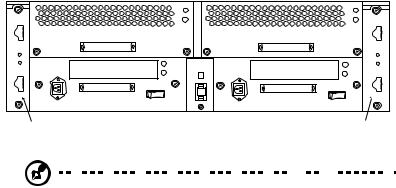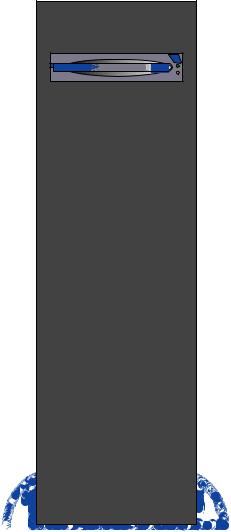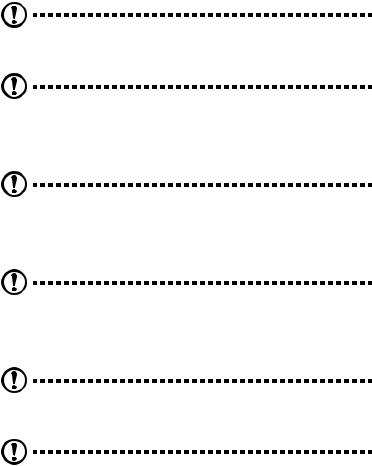Acer AAS700, S700, S700F User Manual
Altos S700 Series
User’s Guide
Copyright © 2002 Acer Incorporated
All Rights Reserved.
Altos S700 Series
User’s Guide
Changes may be made periodically to the information in this publication without obligation to notify any person of such revision or changes. Such changes will be incorporated in new editions of this manual or supplementary documents and publications. This company makes no representations or warranties, either expressed or implied, with respect to the contents hereof and specifically disclaims the implied warranties of merchantability or fitness for a particular purpose.
Record the model number, serial number, purchase date, and place of purchase information in the space provided below. The serial number and model number are recorded on the label affixed to your computer. All correspondense concerning your unit should include the serial number, model number, and purchase information.
No part of this publication may be reproduced, stored in a retrieval system, or transmitted, in any form or by any means, electronic, mechanical, photocopy, recording, or otherwise, without the prior written permission of Acer Incorporated.
Model Number : _________________________________
Serial Number: ___________________________________
Purchase Date: ___________________________________
Place of Purchase: ________________________________
Acer and the Acer logo are registered trademarks of Acer Inc. Other company’s product names or trademarks are used herein for identification purposes only and belong to their respective companies.
Preface |
vii |
Audience |
vii |
Conventions Used In This User Guide |
vii |
European Community Statement |
xv |
Introduction |
3 |
Features |
4 |
Disk Drive Carrier |
4 |
Power Supplies |
4 |
Cooling System |
5 |
I/O Option Modules |
6 |
Safety Statements |
13 |
Unpacking and Initial Setup |
15 |
Installing the System in an Equipment Rack |
16 |
Ambient Temperature |
16 |
Air Flow |
16 |
Mechanical Loading |
16 |
Electrical Considerations |
18 |
Circuit Overloading |
18 |
Setting Fibre Channel Loop Speed (2Gb or 1Gb) |
19 |
2Gb Operation |
19 |
1Gb Operation |
19 |
Split Fibre Channel Loop Operation (Quad Loop) |
21 |
Setting Up Split Loop Operation |
21 |
Removing Split Loop Operation |
21 |
Configuration Rules |
23 |
Supported Host Bus Adapters |
24 |
Supported Cables |
25 |
Copper Cables |
25 |
Optical Cables |
26 |
Setting the Enclosure ID |
29 |
Configurations |
32 |
JBOD Configurations |
33 |
Dual FC Loop Configuration |
33 |
Quad Loop Configuration |
35 |
Connecting a Power Source |
37 |
Connecting an AC Power Source |
37 |
Disk Drive Spin Up Sequence |
38 |
Altos S700 Series RAID Controller Introduction |
41 |
RAID Controller Circuit Boards |
43 |
Controller Circuit Board |
43 |
I/O Circuit Board |
43 |
RS232 Serial Port |
44 |
RAID Controller Location |
45 |
Contents
iv |
Contents |
RAID Controller Status LEDs |
46 |
RAID Controller Configurations |
47 |
Setting the Enclosure ID |
48 |
Configurations |
51 |
Single RAID Controller Configuration |
51 |
Dual RAID Controller Configuration |
54 |
Connecting a Power Source |
57 |
Connecting an AC Power Source |
57 |
Disk Drive Spin Up Sequence |
58 |
Overview |
61 |
LS Module |
62 |
LS Module Features |
62 |
Altos S700 Enclosure LEDs |
63 |
Disk Drive LEDs |
65 |
Power Supply LEDs |
67 |
Advanced Cooling Module (ACM) LEDs |
68 |
RAID Controller LEDs |
69 |
Location of the Components |
73 |
Installing and Removing a Disk Drive Carrier |
74 |
Installing a Disk Drive Carrier |
74 |
Removing a Disk Drive Carrier |
74 |
Installing and Removing an LS Module |
76 |
Installing an LS Module |
76 |
Removing an LS Module |
76 |
Installing and Removing a Power Supply |
78 |
Installing a Power Supply |
78 |
Removing a Power Supply |
78 |
Installing and Removing an Advanced Cooling Module |
79 |
Installing an Advanced Cooling Module |
79 |
Removing an Advanced Cooling Module |
79 |
Installing and Removing an I/O Module/RAID Controller |
80 |
Installing an I/O Module/RAID Controller |
80 |
Removing an I/O Module/RAID Controller |
80 |
Caution: |
82 |
Warning |
88 |
Technical Specifications |
90 |
Host Interface |
90 |
Disk Drive Interface |
90 |
System |
90 |
Redundant, Hot Swappable Components |
90 |
Physical Dimensions |
90 |
Warranty |
91 |
Monitoring |
91 |
Failure Notification |
91 |
v
Disk Drives |
92 |
Power Supply |
92 |
Temperature |
92 |
Humidity |
92 |
Altitude |
92 |
Operational Shock |
93 |
Operational Vibration |
93 |
Regulatory Agency Compliance |
93 |
Equipment and parts necessary for upgrade |
103 |
Upgrading from JBOD to RAID |
103 |
Installing the Battery Backup Unit |
104 |
vi |
Contents |

vii
Preface
This Installation Guide describes the installation and operation of the Altos S700 Series. The following products are covered: AS.S7001.001, AS.S7001.002, AS.S7001.003, AS.S7001.004, AS.S7001.005, AS.S7001.006.
Audience
This Installation Guide is intended for use by the person installing and operating the Altos S700 Series. This Installation Guide describes the operation of the Altos S700 Series only. For details relating to the host system, refer to the documentation supplied with the host system.
Conventions Used In This User Guide
The following conventions are used throughout this Installation Guide.
A NOTE gives general information, such as helpful tips and references to related information.
A CAUTION means take care. There is a risk of causing damage to the equipment or losing data.
A WARNING means beware. There is a risk of electric shock or personal injury. Before working on the enclosure be aware of the hazards that exist.

viii
Notices
FCC notice
This device has been tested and found to comply with the limits for a Class B digital device pursuant to Part 15 of the FCC Rules. These limits are designed to provide reasonable protection against harmful interference in a residential installation. This device generates, uses, and can radiate radio frequency energy, and if not installed and used in accordance with the instructions, may cause harmful interference to radio communications.
However, there is no guarantee that interference will not occur in a particular installation. If this device does cause harmful interference to radio or television reception, which can be determined by turning the device off and on, the user is encouraged to try to correct the interference by one or more of the following measures:
•Reorient or relocate the receiving antenna
•Increase the separation between the device and receiver
•Connect the device into an outlet on a circuit different from that to which the receiver is connected
•Consult the dealer or an experienced radio/television technician for help
Notice: Shield cables
All connections to other computing devices must be made using shielded cables to maintain compliance with FCC regulations.
Notice: Peripheral devices
Only peripherals (input/output devices, terminals, printers, etc.) certified to comply with the Class B limits may be attached to this equipment. Operation with noncertified peripherals is likely to result in interference to radio and TV reception.
Caution! Changes or modifications not expressly approved by the manufacturer could void the user’s authority, which is granted by the Federal Communications Commission, to operate this computer.
ix
Use conditions
This part complies with Part 15 of the FCC Rules. Operation is subject to the following two conditions: (1) this device may not cause harmful interference, and (2) this device must accept any interference received, including interference that may cause undesired operation.
Notice: Canadian users
This Class B digital apparatus meets all requirements of the Canadian Interference-Causing Equipment Regulations.
Remarque à l’intention des utilisateurs canadiens
Cet appareil numérique de la classe B respected toutes les exigences du Règlement sur le matériel brouilleur du Canada.

x
Important safety information
Only a technically qualified person shall access, integrate, configure, and service this product.
Intended application uses
This product was evaluated as Information Technology Equipment (ITE), which may be installed in offices, schools, computer rooms, and similar commercial type locations. The suitability of this product for other Product Categories and Environments (such as medical, industrial, alarm systems, and test equipment), other than an ITE application, may require further evaluation.
Checking the power cords
Warning! To avoid electrical shock, do not attempt to modify or use the supplied AC power cord(s), if they are not the exact type required.
If a power cord(s) supplied is not compatible with the AC wall outlet in your region, get one that meets the following criteria:
•The power cord must be properly rated for the AC voltage in your region.
•The power cord plug cap must have an electrical current rating that is at least 125% of the electrical current rating of the product.
•The power cord plug cap that plugs into the wall socket-outlet must have a grounding-type male plug designed for use in your region.
•The power cord must have safety certifications for your region, and shall be marked with the certification markings.
•The power cord plug cap that plugs into the AC receptacle on the power supply must be an IEC 320, sheet C13, type female connector.
•In Europe, the power cord must be less than 4.5 meters (14.76 feet) long, and it must be flexible <HAR> (harmonized) or VDE certified cordage to comply with the chassis' safety certifications.
•The power supply cord(s) is the main disconnect device to AC power. The socket outlet(s) shall be near the equipment and shall be readily accessible for disconnection.
xi
Multiple power cords
Warning! To avoid electrical shock, disconnect all AC power cords before accessing inside the system.
Earth grounded socket-outlets
Warning! To avoid electrical shock, the system power cord(s) must be plugged into socket-outlet(s) that is provided with a suitable earth ground.
Precautionary reminders
•Over current protection
The system is designed to operate on a 20A AC voltage source that is provided with 20A over current protection. If the AC source for the rack exceeds 20A over current protection, each system must be provided with 20A or less over current supplemental protection. The supplementary over current protection must have the appropriate regional safety certifications for the over current application.
•Power supply modules
Power supply modules have double-pole/neutral fusing.
•Ventilation considerations
The equipment rack must provide sufficient airflow to the front of the system to maintain proper cooling. The rack selected and the ventilation provided must be suitable to the environment in which the system will be used.
•Fans
To avoid injury do not touch moving fan blades.
•Cooling and airflow
For proper cooling and airflow, always install all access covers before turning on the system. Operating the system for longer than five minutes without the covers in place can cause overheating and damage to system components.
•Temperature limits
•The operating temperature of the system, when installed in the rack, must not go below 10 °C (50 °F) or rise above 35 °C (95 °F). Extreme fluctuations in temperature may cause a variety of problems in system, and safety limits may be broken.
•Lifting and Moving
Do not attempt to lift or move the server by the handles on the power supplies.
xii
Equipment rack precautions
Follow the rack manufacturer's safety and installation instructions for proper rack installation.
The following additional rack safety installation measures shall be considered:
•Anchor the equipment rack
The equipment rack must be anchored to an unmovable suitable support to prevent the rack from falling over when one or more systems are fully extended out of the rack assembly. You must also consider the weight of any other devices installed in the rack assembly. The equipment rack must be installed according to the manufacturer's instructions.
•Main AC power disconnect
You are responsible for installing an AC power disconnect for the entire rack unit. This main disconnect must be readily accessible, and it must be labeled as controlling power to the entire unit, not just to the system(s).
•Grounding the rack installation
To avoid the potential for an electrical shock hazard, the rack assembly itself must be suitably earth grounded, according to your local regional electrical codes. This typically will require the rack to have its own separate earth ground. We recommend you consult your local approved electrician.
xiii
Important safety instructions
Read these instructions carefully. Save these instructions for future reference.
1Follow all warnings and instructions marked on the product.
2Unplug this product from the wall outlet before cleaning. Do not use liquid cleaners or aerosol cleaners. Use a damp cloth for cleaning.
3Do not use this product near water.
4Do not place this product on an unstable cart, stand, or table. The product may fall, causing serious damage to the product.
5Slots and openings in the cabinet and the back or bottom are provided for ventilation; to ensure reliable operation of the product and to protect it from overheating, these openings must not be blocked or covered. The openings should never be blocked by placing the product on a bed, sofa, rug, or other similar surface. This product should never be placed near or over a radiator or heat register, or in a built-in installation unless proper ventilation is provided.
6This product should be operated from the type of power indicated on the marking label. If you are not sure of the type of power available, consult your dealer or local power company.
7Do not allow anything to rest on the power cord. Do not locate this product where persons will walk on the cord.
8If an extension cord is used with this product, make sure that the total ampere rating of the equipment plugged into the extension cord does not exceed the extension cord ampere rating. Also, make sure that the total rating of all products plugged into the wall outlet does not exceed the fuse rating.
9Never push objects of any kind into this product through cabinet slots as they may touch dangerous voltage points or short out parts that could result in a fire or electric shock. Never spill liquid of any kind on the product.
10Do not attempt to service this product yourself, as opening or removing covers may expose you to dangerous voltage points or other risks. Refer all servicing to qualified service personnel.
11Unplug this product from the wall outlet and refer servicing to qualified service personnel under the following conditions:
a When the power cord or plug is damaged or frayed b If liquid has been spilled into the product
c If the product has been exposed to rain or water
xiv
dIf the product does not operate normally when the operating instructions are followed. Adjust only those controls that are covered by the operating instructions since improper adjustment of other controls may result in damage and will often require extensive work by a qualified technician to restore the product to normal condition.
eIf the product has been dropped or the cabinet has been damaged
fIf the product exhibits a distinct change in performance, indicating a need for service.
12Replace the battery with the same type as the product's battery we recommend. Use of another battery may present a risk of fire or explosion. Refer battery replacement to a qualified serviceman.
13Warning! Batteries may explode if not handled properly. Do not disassemble or dispose of them in fire. Keep them away from children and dispose of used batteries promptly. Dispose of used batteries according to manufacturer's instructions.
14Use only the proper type of power supply cord set (provided in your accessories box) for this unit. It should be a detachable type: UL listed/CSA certified, type SPT-2, rated 7A 125V minimum, VDE approved or its equivalent. Maximum length is 15 feet (4.6 meters).
xv
European Community Statement
This equipment complies with the following European directives:
EMC Directive 89/336/EEC and amending Directives 92/31/EEC and 93/ 68/EEC Low Voltage Directive 73/23/EEC.
xvi
Chapter 1
Introduction
This Chapter introduces the Altos S700 Series. The main features of the Series are described along with a list of the models that are available.

3
Introduction
The Altos S700 Series provides a highly flexible, high performance storage solution that evolves to meet your changing needs. Based on a modular, “building block” enclosure design, the Altos S700 Series offers exceptional scalability. Each enclosure supports up to 14 disk drives, in a dense 3U form factor. As your storage needs grow, simply add Altos S700 enclosures dynamically - up to a total of 8 enclosures. The Altos S700 Series can be scaled in multiple dimensions, enabling flexible configuration of capacity, performance and functionality, to match and grow with virtually any application or IT environment. The enclosure is available with your choice of copper, or optical I/O modules, with RAID Controller option, and is downward compatible to 1Gbps, protecting your investment. A high performance, industry first
Quad Loop1 (4 FCAL loops on one enclosure) capability provides over 700 MB/s from a single enclosure. 2Gb Fibre Channel connectivity provides simplified cabling and extremely high bandwidth, for outstanding performance in demanding applications.
1 Quad Loop functionality is only available on JBOD systems.
4 |
Chapter 1 Introduction |
Features
•Redundant data paths with dual-ported fibre drives and dual (200MB/s) fibre channel loops for a total of 400 MB/s.
•Quad Loop feature, provides over 700MB/s from a single enclosure.
•RAID controller option to give RAID functionality.
•Downward compatible to 1Gbps.
•Dense enclosure with 14 drives in a 3U form factor.
•Scalable to 112 drives, support for 15K rpm drives.
•Enhanced enclosure services (SES) monitoring and reporting.
•No single point of failure, with redundant, hot-swappable components.
•Intuitive, comprehensive management with Spheras Storage Manager.
•User installable, configurable and on-line maintainable.
•Industry-standard 19-inch rackmount or deskside configuration.
•Dual AC power supplies.
Disk Drive Carrier
The disk drive carrier supports one inch, SCA-2 direct attach disk drives. The Altos S700 Series can hold up to fourteen disk drive carriers. The disk drives can be hot swapped and the disk drive carriers provide for blind mating.
Power Supplies
The Altos S700 Series uses two AC power supplies for normal operation, providing redundancy of the power system. The power supplies can be hot swapped. The AC power supplies provide 673 Watts continuous output power and 853 Watts peak output power. The power supplies provide active current sharing, power factor correction, over current and over voltage protection is also provided. The power supplies have individual power inputs.

5
Caution: Power supply cords shall have conductors with a cross-
sectional area not less than 4mm2. This cross-sectional area corresponds to a minimum 10AWG wire.
Cooling System
Cooling is provided by the two Advanced Cooling Modules (ACMs) located at the rear of the enclosure. Each of the ACM units contain two variable speed fans. The enclosure requires four fans for normal operation, but will operate correctly with one fan failed (redundancy is lost if one fan is failed in either ACM), however, it is recommended that the failed fan be replaced as soon as possible. The ACM units can be hot swapped. The LS Module monitors and controls the speed of each fan. The speed is set depending on the ambient temperature and failed status. The fans are set to full speed if one fan is failed. The following table shows how the fan speed relates to temperature change.
ACM Speed |
|
|
|
|
|
|
|
|
|
|
Ambient Temp (oC) |
|
|
|
|
|
|
|
|
||||||||
Speed 1 |
|
|
|
|
|
|
|
|
|
|
0 to 26 |
|
|
|
|
|
|
|
|
||||||||
|
|
|
|
|
|
|
|
|
|
|
|
|
|
|
|
|
|
|
|
||||||||
Speed 2 |
|
|
|
|
|
|
|
|
|
|
26 to 28 |
|
|
|
|
|
|
|
|
||||||||
|
|
|
|
|
|
|
|
|
|
|
|
|
|
|
|
|
|
|
|
||||||||
Speed 3 |
|
|
|
|
|
|
|
|
|
|
28 to 30 |
|
|
|
|
|
|
|
|
||||||||
|
|
|
|
|
|
|
|
|
|
|
|
|
|
|
|||||||||||||
Full Speed |
|
|
|
|
|
|
|
|
|
|
30 + |
|
|
|
|
|
|
|
|
|
|
|
|
||||
|
|
|
|
|
|
|
|
|
|
|
|
|
|
|
|
|
|
|
|
|
|
|
|
|
|
|
|
|
|
|
|
|
|
|
|
|
|
|
|
|
|
|
|
|
|
|
|
|
|
|
|
|
|
|
|
Note: All fans in an enclosure are set to the same speed.

6 |
Chapter 1 Introduction |
I/O Option Modules
The two rear I/O option slots (A and B) can contain a range of different option modules. The LS module will detect the type of option module installed.
1 |
1 |
2 |
2 |
I |
0 |
I |
0 |
I/O Option |
|
|
|
|
|
|
|
|
|
|
|
|
|
|
|
|
|
|
|
|
|
I/O Option |
|
||
Slot B |
|
|
|
|
|
|
|
|
|
|
|
|
|
|
|
|
|
|
|
|
|
|
Slot A |
|
|
|
|
|
|
|
|
|
|
|
|
|
|
|
|
|
|
|
|
|
|
|
|
|
|
|
|
Note: The above illustration shows the copper/copper I/O option modules.
The available option modules are:
I/O Expansion Module - Copper/Copper
This 2Gb FC expansion module has two HSSDC connectors. The top connector is the primary FC loop input port and the bottom connector is available for FC loop expansion / input. A fibre channel loop back terminator is not required.
I/O Expansion Module - Optical/Copper
This 2Gb FC expansion module has the SFF LC optical connector as the FC Loop Input port. The FC loop expansion is carried out by the HSSDC connector. A loop back terminator is not required.
7
I/O Expansion ModuleOptical/Optical
This 2Gb FC expansion module has two SFF LC optical connectors. The top connector is the FC Loop Input port and the bottom connector is for FC Loop Expansion. A loop back terminator is not required.
Altos S700 RAID Controller
The Altos S700 RAID Controller is a high performance controller, providing two host fibre channel and two device fibre channel interfaces. It is an intelligent, caching controller that supports RAID levels 0, 1, 3, 5, 0+1, and JBOD. The controller enables multiple hosts to access an array of disk drives, which can be configured as one or more virtual storage devices (logical units).

8 |
Chapter 1 Introduction |
Figure 1-1: Altos S700 Series Tower Model

9
Figure 1-2: Altos S700 Series Rack Model
10 |
Chapter 1 Introduction |
Chapter 2
Installation and Setup

This Chapter describes the installation and set up of the Altos S700 Series. Important safety instructions are discussed along with the electrical, mechanical and environmental precautions that need to be taken. Items that need to be set prior to operating the Altos S700 enclosure are also described here.
Note: Please read this Chapter carefully before attempting to install or operate the Altos S700 Series enclosure.

13
Safety Statements
The following safety statements must be read before you install or operate the Altos S700 Series. For language translations of these statements refer to Appendix B.
Caution: This equipment is intended only for installation in a restricted access location.
Caution: Before attempting to install or remove any of the components, ensure that anti-static precautions are taken. The minimum requirement is, a properly grounded anti-static wrist strap and ground wire.
Caution: If any of the components are removed the resulting hole must be blocked, by installing a component blank or replacing the component. Failure to do so can seriously restrict air flow and cooling.
Caution: This device should be connected to a power source which carries a fuse or circuit breaker that is greater than the rating of the shelf, but also complies with national wiring standards.
Caution: Allow disk drives and power supplies to reach room ambient temperature before powering on the shelf.
Caution: It is recommended that, if interconnecting equipment resides within more than one equipment rack cabinets, these equipment racks should be at the same ground potential.

14 |
|
|
|
|
|
|
|
|
|
|
Chapter 2 Installation and Setup |
|||||||||||||||
|
|
|
|
|
|
|
|
|
|
|
|
|
|
|
|
|
|
|
|
|
|
|
|
|
|
|
Warning: A possible shock hazard may exist in the area of the fan connection.
Warning: Disconnect the power cords before removing a power supply from the enclosure.
